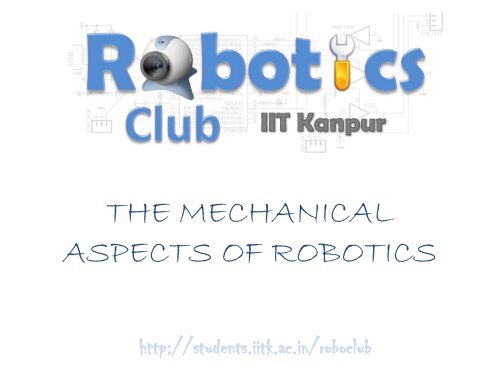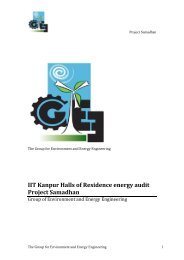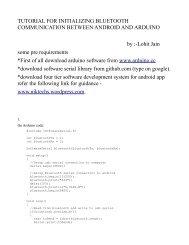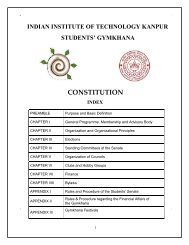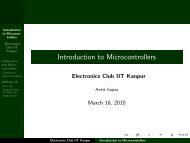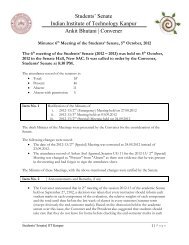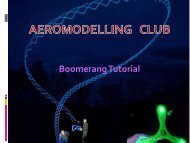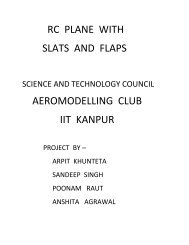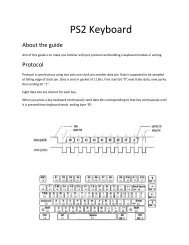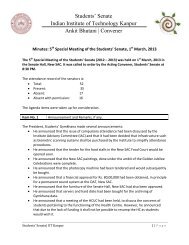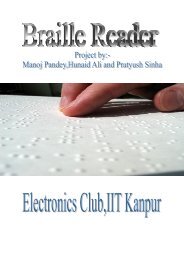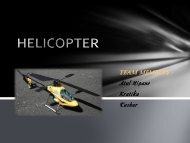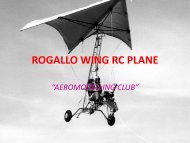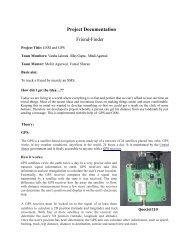THE MECHANICAL ASPECTS OF ROBOTICS
THE MECHANICAL ASPECTS OF ROBOTICS
THE MECHANICAL ASPECTS OF ROBOTICS
Create successful ePaper yourself
Turn your PDF publications into a flip-book with our unique Google optimized e-Paper software.
<strong>THE</strong> <strong>MECHANICAL</strong><br />
<strong>ASPECTS</strong> <strong>OF</strong> <strong>ROBOTICS</strong><br />
http://students.iitk.ac.in/roboclub
Mechanical<br />
aspects<br />
Actuators<br />
The basic<br />
structure<br />
Circuitry<br />
Motors (DC<br />
Motors, Servo,<br />
Stepper, Encoder)<br />
Hydraulics<br />
Mechanisms<br />
(gears, etc.)<br />
Micro-controller<br />
(Arduino)<br />
The motor drivers<br />
(L293D, L298,<br />
MOSFET)
DC Motors<br />
• These are simple motors used for<br />
simple purpose.<br />
• Apply +12V (generally) and they start<br />
rotating. Apply -12V and they rotate<br />
in the opposite direction!<br />
• Speed can be reduced by reducing the<br />
voltage supplied, however that’s not<br />
an efficient way of doing things.<br />
• Torque and speed are inter-related. A<br />
10rpm motor has relatively high<br />
torque. Generally a 100rpm – 300rpm<br />
motor is used as the wheels of a robot
Servo Motors<br />
• They are used for specific purposes (for<br />
instance, in grippers, etc.)<br />
• They have a restricted rotation of 180 o or<br />
360 o . The least rotation angle possible is<br />
1 o .<br />
• They are driven through<br />
microcontrollers. Power comes separately<br />
from a battery (12V, generally).<br />
• Arduino has one line command for<br />
driving a servo . Using an Atmega PWM<br />
needs to be generated to drive a servo.<br />
• Speed can be reduced by sending the<br />
commands at a delay. This doesn’t reduce<br />
the efficiency of the motor.
Stepper Motors<br />
• Stepper motors, unlike ordinary DC<br />
motors, are brushless and can divide a<br />
full 360° into a large number of steps, for<br />
example 200.<br />
• Unlike servo motors, their rotation is<br />
not restricted.<br />
• Stepper motors have got a different<br />
mechanism for rotation. The four<br />
electromagnets are activated successively<br />
and this causes the disc to rotate. Each<br />
activation results in a small rotation,<br />
called a step, generally of 1.8 o .<br />
• Again, speed can be varied by applying a<br />
delay in the control signal send to the
Encoder Motors<br />
• High quality DC motors, with a feedback mechanism.<br />
• The encoders can be optical or magnetic.<br />
• They measure the rotation of the DC motor and give a feedback of<br />
the amount of rotation done, so that the rotation can be controlled.<br />
• Finds use in situations similar to where stepper motors are used.
Circuitry (Driving the motors)<br />
• The microcontrollers like Atmega16 and Arduino have a current<br />
rating of 5-10 mA.<br />
• The normal DC motor’s current ratings start from 150 mA and<br />
above.<br />
• So the motor cannot be directly attached to the Atmega, hence a<br />
motor-driver is used.<br />
• Generally, L298, L293 are used to drive simple DC motors. The<br />
servo motors already have a power cable and a different control<br />
cable which can directly be connected to the microcontrollers.<br />
L298, UART can drive the stepper motors.<br />
• More about the circuitry will be covered in the further lectures…
The mechanical model<br />
• Different mechanical models are made depending on the task<br />
needed to be achieved through the robot.<br />
• This is where the innovation lies!<br />
• While designing a mechanical model we need to think about the<br />
task, the time, the feasibility; we need to think in different<br />
dimensions.<br />
• We shall discuss some methods of motion transference through<br />
gears and other utilities. However, implementing them is difficulty<br />
because while implementing we can face various difficulties of<br />
giving support, ensuring less friction, proper synchronization, etc.<br />
Also, arranging particular type of gears is difficult.
Rotation to linear motion<br />
We many-a-times need some linear motion in our<br />
robots.<br />
In the forthcoming slides I have listed some of the<br />
mechanisms that I have used. You may come up with<br />
your own!
2. Rack and Pinion
4. Conveyer Belt<br />
This is a simple way to achieve linear motion. It doesn’t have<br />
much complicacies and could be easily implemented. I used it in<br />
my robot.
Other mechanisms<br />
• Scissor mechanism<br />
• Spring mechanism
Some other useful things<br />
Ball Bearings.<br />
• Support for minimizing<br />
friction.<br />
• Generally not needed,<br />
as friction is not much<br />
Omni wheels.<br />
• Special types of wheels<br />
is motion is desired in<br />
both x and y directions.<br />
Castor wheels.<br />
• Provides a one point<br />
support minimizing<br />
friction.
Thank You!<br />
Prashant Jalan, B-306/5, 8960402355<br />
Abhishek Attal, 273/2, 8009961678<br />
Saket Kanodia, A326/10, 8765696051<br />
https://www.facebook.com/groups/roboclub.iitk/<br />
http://students.iitk.ac.in/roboclub/


